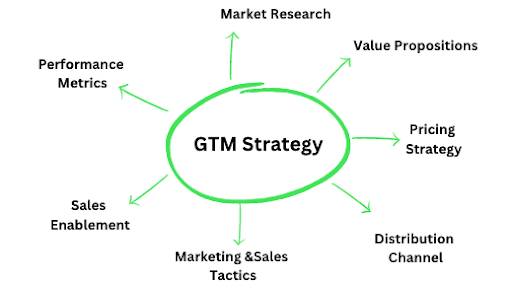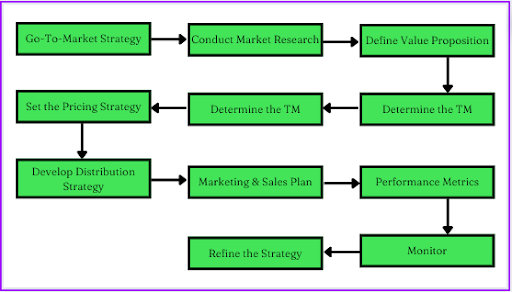Go to Market Strategy
Definition
A go-to-market (GTM) strategy refers to a business’s plan and actions to bring its product or service to market and acquire customers.
Description
The GTM strategy typically includes identifying the target market, defining the value proposition, setting the pricing strategy, determining the distribution channels, developing the marketing and sales tactics, and analysing the competition.
A well-defined GTM strategy can help a business launch its product or service effectively, reach the right audience, and generate revenue.
A go-to-market (GTM) strategy is an essential business process that defines how a company will bring its products or services to market and reach its target customers.
It is a comprehensive approach that covers all aspects of product development, marketing, sales, and distribution.
The main components of a GTM strategy typically include the following:

- Market Research: Understanding the target market, customer needs, and market trends are critical to developing a successful GTM strategy.
- Value Proposition: The unique selling points of a product or service and how it solves a customer’s problem or meets their needs.
- Pricing Strategy: Determining the price point that is competitive, profitable, and aligned with customer expectations.
- Distribution Channels: Identifying the most effective channels to distribute the product or service to the target audience, whether direct sales, partnerships, or online marketplaces.
- Marketing and Sales Tactics: Creating a comprehensive plan to promote the product or service, including advertising, content marketing, social media, email campaigns, and more.
- Sales Enablement: Equipping the sales team with the necessary tools and training to sell the product or service effectively.
- Performance Metrics: Measuring the success of the GTM strategy through key performance indicators (KPIs), such as sales revenue, customer acquisition, retention, and market share.
A well-crafted GTM strategy can help businesses create a competitive advantage, maximise customer engagement, and increase revenue. It also provides a roadmap for continuous improvement and refinement of the sales and marketing process.
Importance of Go-to-Market Strategy
A go-to-market (GTM) strategy is crucial for the success of any business that wants to bring a product or service to market. Here are some of the key reasons why a well-defined GTM strategy is so important:
- Aligns Business Goals: A GTM strategy helps align the company’s goals with its marketing and sales objectives. It provides a roadmap for launching and promoting products or services to the target audience.
- Identifies Target Market: A GTM strategy helps identify the target market, including its needs, preferences, and behaviour. This information enables businesses to develop effective marketing and sales tactics to engage the target audience.
- Defines Unique Value Proposition: A GTM strategy defines the unique value proposition of the product or service, which helps differentiate it from competitors. This is critical for creating a competitive advantage in the market.
- Optimises Resource Allocation: A GTM strategy helps optimise the allocation of resources, including budget, time, and talent. It ensures that these resources are focused on the most effective marketing and sales tactics to achieve business objectives.
- Enables Continuous Improvement: A GTM strategy provides a framework for ongoing analysis and refinement of marketing and sales tactics. This helps businesses to continuously improve their approach and increase the effectiveness of their GTM strategy.
- Facilitates Decision Making: A GTM strategy provides the information and insights to make informed decisions about product development, pricing, distribution, and marketing.
How to prepare a Go-to-Market strategy?
Preparing a go-to-market (GTM) strategy requires a comprehensive approach that covers all aspects of product development, marketing, sales, and distribution. Here are the general steps for preparing a GTM strategy:

- Conduct Market Research: This involves researching the target market, customer needs, and market trends to better understand the competitive landscape and potential demand for the product or service.
- Define the Value Proposition: This involves identifying the unique selling points of the product or service, how it solves a customer’s problem or meets their needs, and how it differs from competitors.
- Determine the Target Market: This involves identifying the specific customer segments for which the product or service is intended and creating customer personas to guide marketing and sales efforts.
- Set the Pricing Strategy: This involves determining the optimal price point that is competitive, profitable, and aligned with customer expectations.
- Develop the Distribution Strategy: This involves identifying the most effective channels to distribute the product or service to the target audience, whether through direct sales, partnerships, or online marketplaces.
- Create the Marketing and Sales Plan: This involves developing a comprehensive plan to promote the product or service, including advertising, content marketing, social media, email campaigns, and more. It also equips the sales team with the necessary tools and training to sell the product or service effectively.
- Establish Performance Metrics: This involves defining key performance indicators (KPIs) to measure the success of the GTM strategy, such as sales revenue, customer acquisition, retention, and market share.
- Continuously Monitor and Refine the Strategy: This involves regularly reviewing and analysing the performance metrics to identify areas of improvement and refining the GTM strategy accordingly.
Future of Go-to-Market Strategy
The business world constantly evolves, and the go-to-market (GTM) strategy is no exception. Here are some of the future trends that are expected to impact the GTM strategy:
- Personalization: As customers demand more personalised experiences, GTM strategies must focus on developing targeted marketing and sales approaches that resonate with individual customer needs and preferences.
- Digitalization: With the rise of digital channels, GTM strategies must adapt to reach customers through online marketplaces, social media, and other digital platforms.
- Sustainability: As consumers become more conscious of sustainability and ethical considerations, GTM strategies must emphasise environmentally-friendly products and practices to meet customer demands.
- Integration: GTM strategies must integrate all aspects of the customer journey, from product development to post-sale support, to create a seamless and satisfying customer experience.
- Data Analytics: With the increasing availability of data and analytics tools, GTM strategies must leverage these insights to make informed decisions about product development, pricing, distribution, and marketing.
- Artificial Intelligence: Artificial intelligence (AI) is expected to play an increasingly important role in GTM strategies, with AI-powered chatbots and other tools helping streamline customer support and enhance the overall customer experience.
- Collaboration: GTM strategies will need to emphasise cooperation across teams and departments to ensure that all aspects of the business are aligned with the GTM objectives.
Benefits of Go-to-Market Strategy
A well-executed go-to-market (GTM) strategy can bring numerous benefits to a business, including:
- Faster Time to Market: A GTM strategy ensures that a product or service is launched efficiently, reducing the time to market and enabling the business to capitalise on market opportunities quickly.
- Competitive Advantage: A GTM strategy helps businesses stand out by differentiating their product or service and emphasising their unique value proposition.
- Improved Sales: A GTM strategy provides a roadmap for reaching target customers, identifying the most effective sales channels, and creating targeted marketing campaigns, increasing sales and revenue.
- Greater Customer Satisfaction: A GTM strategy helps businesses better understand their target customers, develop products that meet their needs, and deliver a positive customer experience, resulting in higher customer satisfaction and loyalty.
- Increased Market Share: A GTM strategy enables businesses to gain a more significant market share by identifying and targeting underserved customer segments and creating products and services that meet their needs.
- Cost Efficiency: A GTM strategy helps businesses optimise their marketing and sales efforts, reducing costs and improving profitability.
- Improved Agility: A GTM strategy enables businesses to respond quickly to market, or customer needs changes by providing a framework for decision-making and adaptability.
Example
Apple is well-known for its successful go-to-market (GTM) strategies, and the launch of the iPhone in 2007 is a prime example. Apple’s GTM strategy for the iPhone was based on several key elements.
First, they focused on product differentiation, emphasising the iPhone’s sleek design, intuitive user interface, and advanced features such as a high-quality camera and touch screen.
Second, Apple targeted a specific market of tech-savvy consumers who valued innovation and design. Third, their marketing efforts emphasised the iPhone’s unique features and benefits, such as its ability to surf the internet and play music.
Third, Apple launched the iPhone exclusively through AT&T in the United States, creating a sense of exclusivity and scarcity that helped generate buzz and demand for the product.
Fourth, Apple priced the iPhone higher than other smartphones on the market, positioning it as a premium product that offered superior value to consumers who valued innovation and design.
Finally, Apple partnered with third-party app developers to create a robust app store that offered a wide range of apps and games, which helped to increase the iPhone’s appeal and usability.
Overall, Apple’s GTM strategy for the iPhone was highly influential, generating significant buzz and demand for the product and helping to establish Apple as a leading player in the smartphone market.
FAQs
Why is a go-to-market strategy important?
A go-to-market strategy is essential because it helps a company to effectively target and reach its intended customers, differentiate itself from competitors, and maximise its chances of success in the marketplace.
What are the critical components of a go-to-market strategy?
The key components of a go-to-market strategy typically include identifying the target market and customer segments, defining the value proposition and messaging, determining the sales and distribution channels, and establishing pricing and promotional strategies.
How do you develop a go-to-market strategy?
Developing a go-to-market strategy typically involves conducting market research, analysing the competitive landscape, identifying customer needs and pain points, and aligning the company’s capabilities and resources with its business objectives.
How do you measure the success of a go-to-market strategy?
The success of a go-to-market strategy can be measured using a variety of metrics, such as customer acquisition and retention rates, sales revenue, market share, and customer satisfaction and loyalty.
Can a go-to-market strategy be changed or adapted over time?
A go-to-market strategy should be viewed as a dynamic plan that can be adjusted as market conditions, customer needs, and competitive pressures change over time.
Therefore, companies should regularly monitor and evaluate their go-to-market strategies to remain practical and relevant.





We would love to have your opinion.